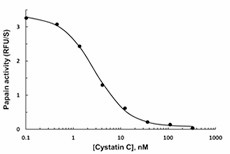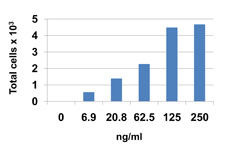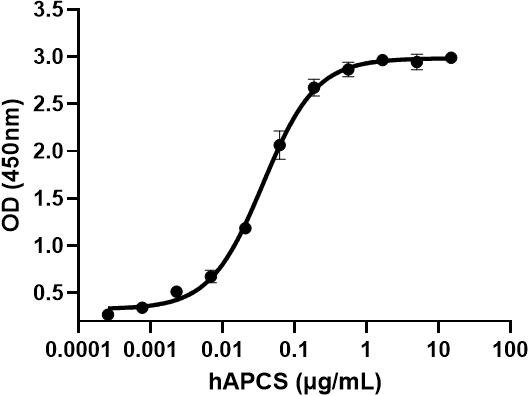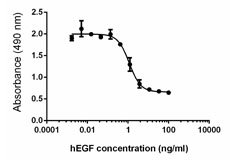- Regulatory Status
- RUO
- Other Names
- Cystatin-3, Gamma-trace, Neuroendocrine basic polypeptide, Post-gamma-globulin, gamma-CSF, post-gamma protein
- Ave. Rating
- Submit a Review
- Product Citations
- publications

-

The activity of human Cystatin C was measured by its ability to inhibit papain activity. The papain activity was monitored by the cleavage of a fluorogenic substrate, Z-FR-AMC, with 50 ng/mL of activated papain. The recombinant human Cystatin C displays a value of IC50 < 6 nM.
Cystatin C was initially identified in human urine and was named gamma-trace. It is a type II cystatin sub-family member. The cystatin family contains three subfamilies: Type 1 cystatins, also known as stefins, which are predominantly present in the cytosol and the nuclei; Type 2 cystatins are mainly secreted proteins; Type 3 cystatins are multi-domain proteins of high molecular weight (60-120 kD) and are also known as kininogens. Cystatin C inhibits cysteine proteases from the papain family and legumain. It forms tight non-covalent associations with its target enzymes. Cystatin C antagonizes TGF-β signaling in normal and cancer cells in vitro. In this process, Cystatin C binds to the TGF-β type II receptor and inhibits the binding of TGF-β. Cystatin C influences the progression of diseases such as, cancer metastasis, atherosclerosis, aortic aneurisms, emphysema, and arthritis. Also, it is associated with neurodegenerative disease and cerebral angiopathy. Human Cystatin C has the tendency to dimerize in order to produce very tight two-fold symmetric dimers. This amyloidogenic property suggests a mechanism for its aggregation in the brain arteries of elderly people with amyloid angiopathy. The L68Q mutant of human Cystatin C is responsible for conformational disease, which causes massive amyloidosis, cerebral hemorrhage, and death in young adults.
Product DetailsProduct Details
- Source
- Human Cystatin C, amino acids (Ser27-Ala146) (Accession# P01034), was expressed in 293E cells. The carboxi terminal contains a TG-10His-GGQ-tag.
- Molecular Mass
- The 135 amino acid recombinant protein has a predicted molecular mass of approximately 15.1 kD. The DTT-reducing and non-reducing protein migrates at approximately 17 kD by SDS-PAGE. The predicted N-terminal amino acid is Ser.
- Purity
- >95%, as determined by Coomassie stained SDS-PAGE.
- Formulation
- 0.22 µm filtered protein is in 20 mM HEPES, 0.1 M NaCl, and in pH 7.2.
- Endotoxin Level
- Less than 0.1 EU per µg cytokine as determined by the LAL method.
- Concentration
- 10 and 25 µg sizes are bottled at 200 µg/mL. 100 µg size and larger sizes are lot-specific and bottled at the concentration indicated on the vial. To obtain lot-specific concentration and expiration, please enter the lot number in our Certificate of Analysis online tool.
- Storage & Handling
- Unopened vial can be stored between 2°C and 8°C for up to 2 weeks, at -20°C for up to six months, or at -70°C or colder until the expiration date. For maximum results, quick spin vial prior to opening. The protein can be aliquoted and stored at -20°C or colder. Stock solutions can also be prepared at 50 - 100 µg/mL in appropriate sterile buffer, carrier protein such as 0.2 - 1% BSA or HSA can be added when preparing the stock solution. Aliquots can be stored between 2°C and 8°C for up to one week and stored at -20°C or colder for up to 3 months. Avoid repeated freeze/thaw cycles.
- Activity
- IC50 < 6.0 nM, as determined by inhibiting human Papain (0.05 µg/mL) activity when 100 uM of Z-FR-AMC is used as a papain peptide substrate.
- Application
-
Bioassay
- Application Notes
-
BioLegend carrier-free recombinant proteins provided in liquid format are shipped on blue-ice. Our comparison testing data indicates that when handled and stored as recommended, the liquid format has equal or better stability and shelf-life compared to commercially available lyophilized proteins after reconstitution. Our liquid proteins are verified in-house to maintain activity after shipping on blue ice and are backed by our 100% satisfaction guarantee. If you have any concerns, contact us at tech@biolegend.com.
- Product Citations
-
Antigen Details
- Structure
- Monomer.
- Distribution
-
Considered ubiquitously expressed, biological fluids, dendritic cells, and macrophages.
- Function
- Inhibitor of cysteine proteases (capthepsins B, H, K, L, and S). Transcription factor IFN regulatory factor 8 (IRF-8) induces cystatin C in mouse primary dendritic cells. IL-10 inhibits IRF-8 and consequently Cystatin C.
- Interaction
- Normal and cancer cells.
- Ligand/Receptor
- Papain-like cysteine proteases, cathepsins B, H, K, L, and S, and legumain.
- Bioactivity
- Inhibits cystein proteases.
- Biology Area
- Cancer Biomarkers, Cell Biology
- Molecular Family
- Enzymes and Regulators
- Antigen References
-
1. Grubb A, et al. 1982. Proc. Nat. Acad. Sci. 79:3024.
2. Janowski R, et al. 2001. Nat. Struct. Biol. 8:316.
3. Sokol JP, Schiemann WP. 2004. Mol. Cancer Res. 2:183.
4. Bird PI, et al. 2009. Nat Rev Immunol. 9:871.
5. Kaur G, Levy E. 2012. Front Mol. Neurosci. 5:79.
6. Xu Y, et al. 2014. J Biol Chem. 289:9730.
7. Xu Y, et al. 2015. Immunol. Cell Biol. 5:442-51. - Gene ID
- 1471 View all products for this Gene ID
- UniProt
- View information about Cystatin C on UniProt.org
Related Pages & Pathways
Pages
Related FAQs
- Why choose BioLegend recombinant proteins?
-
• Each lot of product is quality-tested for bioactivity as indicated on the data sheet.
• Greater than 95% Purity or higher, tested on every lot of product.
• 100% Satisfaction Guarantee for quality performance, stability, and consistency.
• Ready-to-use liquid format saves time and reduces challenges associated with reconstitution.
• Bulk and customization available. Contact us.
• Learn more about our Recombinant Proteins. - How does the activity of your recombinant proteins compare to competitors?
-
We quality control each and every lot of recombinant protein. Not only do we check its bioactivity, but we also compare it against other commercially available recombinant proteins. We make sure each recombinant protein’s activity is at least as good as or better than the competition’s. In order to provide you with the best possible product, we ensure that our testing process is rigorous and thorough. If you’re curious and eager to make the switch to BioLegend recombinants, contact your sales representative today!
- What is the specific activity or ED50 of my recombinant protein?
-
The specific activity range of the protein is indicated on the product datasheets. Because the exact activity values on a per unit basis can largely fluctuate depending on a number of factors, including the nature of the assay, cell density, age of cells/passage number, culture media used, and end user technique, the specific activity is best defined as a range and we guarantee the specific activity of all our lots will be within the range indicated on the datasheet. Please note this only applies to recombinants labeled for use in bioassays. ELISA standard recombinant proteins are not recommended for bioassay usage as they are not tested for these applications.
- Have your recombinants been tested for stability?
-
Our testing shows that the recombinant proteins are able to withstand room temperature for a week without losing activity. In addition the recombinant proteins were also found to withstand four cycles of freeze and thaw without losing activity.
- Does specific activity of a recombinant protein vary between lots?
-
Specific activity will vary for each lot and for the type of experiment that is done to validate it, but all passed lots will have activity within the established ED50 range for the product and we guarantee that our products will have lot-to-lot consistency. Please conduct an experiment-specific validation to find the optimal ED50 for your system.
- How do you convert activity as an ED50 in ng/ml to a specific activity in Units/mg?
-
Use formula Specific activity (Units/mg) = 10^6/ ED50 (ng/mL)
 Login / Register
Login / Register 












Follow Us